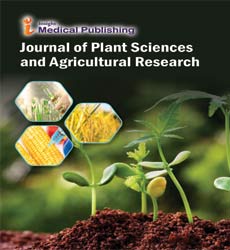Abiotic Stress-Induced Regulation of Secondary Metabolite Biosynthesis in Plants
Nazir Moural*
Department of Crop and Soil Sciences, Cornell University, Ithaca, USA
- *Corresponding Author:
- Nazir Moural
Department of Crop and Soil Sciences, Cornell University, Ithaca,
USA,
E-mail: moural_n@gmail.com
Received date: November 20, 2024, Manuscript No. IPJPSAR-24-20180; Editor assigned date: November 22, 2024, PreQC No. IPJPSAR-24-20180 (PQ); Reviewed date: December 06, 2024, QC No. IPJPSAR-24-20180; Revised date: December 13, 2024, Manuscript No. IPJPSAR-24-20180 (R); Published date: December 20, 2024, DOI: 10.36648/ipjpsar.8.4.159
Citation: Moural N (2024) Abiotic Stress-Induced Regulation of Secondary Metabolite Biosynthesis in Plants. J Plant Sci Agri Res Vol.8 No.4: 159.
Description
Plants, like all living organisms, are constantly exposed to environmental stress factors that can signi icantly impact their growth, development and productivity. Among these, abiotic stresses, such as drought, salinity, extreme temperatures and heavy metals, are some of the most common and detrimental. To cope with these challenges, plants have evolved intricate mechanisms that enable them to survive and thrive under adverse conditions.
Activation of stress-signaling pathways
When plants are subjected to abiotic stress, a series of signaling pathways are activated to regulate the synthesis of secondary metabolites. These pathways are typically initiated by the perception of stress signals, which may include the generation of Reactive Oxygen Species (ROS), changes in cellular osmotic pressure or the activation of stress hormones like Abscisic Acid (ABA), Jasmonic Acid (JA) or Salicylic Acid (SA). ROS, such as hydrogen peroxide and superoxide radicals, are known to accumulate in response to environmental stress and they act as signaling molecules that trigger various stress responses, including the induction of secondary metabolite biosynthesis.
For example, the synthesis of phenolic compounds, which are known for their antioxidant properties, is o ten triggered by oxidative stress. These compounds help to neutralize ROS and protect cellular structures from damage. The increase in phenolic production is o ten associated with the upregulation of key enzymes in the phenylpropanoid pathway, such as Phenylalanine Ammonia-Lyase (PAL), which plays an important role in the biosynthesis of lavonoids, lignins and other polyphenols.
Hormones are central to the regulation of secondary metabolite biosynthesis in response to abiotic stress. The plant hormones ABA, JA and SA are particularly important in modulating this process. ABA, for instance, is primarily involved in regulating plant responses to drought and salinity stress. When plants face water de icit, ABA levels increase, triggering stomatal closure and the activation of various protective mechanisms, including the production of secondary metabolites.
Similarly, JA plays a key role in the defense response against both biotic and abiotic stresses. It is involved in regulating the synthesis of terpenoids and alkaloids, which help plants defend against herbivores and pathogens. Under stress conditions such as drought or salinity, JA signaling pathways are activated, leading to the upregulation of genes involved in the biosynthesis of protective secondary metabolites. On the other hand, SA is primarily linked to the plant's defense against pathogens but also has a role in modulating the production of certain secondary metabolites, such as phenolic acids, in response to abiotic stresses.
Secondary metabolites are synthesized through complex enzymatic pathways, which are o ten modulated by abiotic stress conditions. For instance, the accumulation of lavonoids and anthocyanins, which provide antioxidant and UV-protective roles, is regulated by the enzymes involved in the lavonoid biosynthesis pathway. The activation of enzymes like Chalcone Synthase (CHS), Flavonoid 3’-Hydroxylase (F3’H) and Anthocyanidin Synthase (ANS) in response to abiotic stress enhances the plant's ability to withstand oxidative damage.
The biosynthesis of secondary metabolites in response to abiotic stress is not merely a protective mechanism but also plays a signi icant role in enhancing the plant’s overall stress tolerance. Secondary metabolites help plants survive in harsh environments by scavenging ROS, stabilizing cell membranes and regulating ion homeostasis, all of which contribute to mitigating the negative effects of abiotic stress.
Regulation of osmotic stress and ion homeostasis
Abiotic stresses such as drought and salinity o ten lead to osmotic stress and imbalances in ion concentrations within plant cells. Secondary metabolites help regulate osmotic pressure by accumulating in the vacuoles or extracellular spaces, thereby stabilizing cell turgor. Additionally, compounds like glycine betaine and proline, which are classi ied as compatible solutes, are synthesized under stress and contribute to maintaining ion homeostasis, reducing cellular dehydration and protecting proteins and membranes from denaturation.
While secondary metabolites are primarily involved in stress defense, they can also in luence plant growth and development under stress conditions. For example, the accumulation of certain secondary metabolites can help maintain plant photosynthetic efficiency by stabilizing the photosystem under extreme temperatures or drought. Furthermore, secondary metabolites like phytoalexins and terpenoids have been shown to modulate hormonal pathways that regulate plant growth and stress adaptation.
Abiotic stress induces complex regulatory mechanisms in plants, leading to the enhanced production of secondary metabolites that play critical roles in mitigating stress effects. The interplay between stress signaling, hormonal regulation and enzymatic pathways determines the synthesis of these metabolites, which in turn helps plants adapt to and survive in challenging environments. Understanding the mechanisms that control secondary metabolite biosynthesis under abiotic stress can open new methods for improving crop resilience through breeding, genetic engineering and agricultural practices. By harnessing the power of secondary metabolites, it may be possible to develop plants that are better equipped to withstand the increasingly unpredictable environmental conditions caused by climate change.
Open Access Journals
- Aquaculture & Veterinary Science
- Chemistry & Chemical Sciences
- Clinical Sciences
- Engineering
- General Science
- Genetics & Molecular Biology
- Health Care & Nursing
- Immunology & Microbiology
- Materials Science
- Mathematics & Physics
- Medical Sciences
- Neurology & Psychiatry
- Oncology & Cancer Science
- Pharmaceutical Sciences
